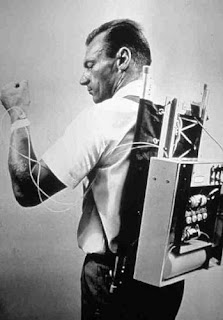The Progression of Insulin Pumps
I don’t know if I have already mentioned this enough, but I
am absolutely in love with my insulin pump. I love that it’s small, light
weight, convenient, and that it has given me better control on my blood sugars.
It’s the best, plain and simple, sure there are complications from time to
time, it’s kind of like a relationship you’re going to bicker and get frustrated
with each other, but at the end of the day the only thing that matters is the
fact that you choose to stick together. Not my best analogy, but in my brain it
worked.
Insulin pumps have been around longer than I have. I mean
the first insulin pump came out in the 60’s and looked a lot like a jet pack.
But lets be honest it was kind of the coolest looks wise I mean who wouldn’t
want to rock a jet pack? Not only did the original deliver insulin, it also
delivered glucagon, for those of you who do not know what glucagon is, it is
the hormone secreted by your liver to bring your blood sugar levels up. Dr.
Arnold Kadis made the first insulin pump in Los Angeles in 1963.
In the 1970’s Dean Kamen created the auto-syringe that was
carried in a backpack and connected to the person with tubing and a needle. It
wasn’t until 1979, that a needle free insulin pump was created. It was smaller
and looked similar to today’s pumps, but weighed about 2 pounds. But both of
these methods were inaccurate causing fatalities and most diabetics to go back
to daily injections.
The 1980’s were not any better. You would have to use a screwdriver
to change your insulin dosage because they didn’t have any buttons. These were
only used in cases that were difficult to manage and often leaving patients
unsatisfied.
In the 1990’s Minimeds finally arrived! They were smaller
and more convenient to use. This was the first insulin pump to really interact
with the patients using them. They only delivered one set basal dose and
unfortunately left people with low blood sugars.
Now day’s pumps pretty much think for you. They are
downloadable, communicative with other devices such as the continuous glucose
monitor, and have temporary basal settings; bolus overrides to prevent lows,
and much, much more. I am all about my insulin pump and love that we no longer
have to be subjected to a jet pack.







Tx for the history recap, it makes me feel less critical of lack of customized features to appreciating how much better they are now.
ReplyDeleteJet packs are cool though :)
ReplyDelete